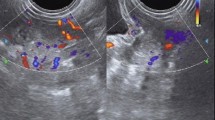Summary
The banding characteristics of an extreme variant familial chromosome 22 short-arm enlargement are described. Ag-AS staining for nucleolar-organizer regions, identified two areas of rDNA actively coding for 18S and 28S rRNA, the one being a broad distal Ag-band and the other a narrower centromeric Ag-band. The DNA in the major portion of the enlarged short arm was highly methylated, as shown by the binding of antibodies to 5-methylcytidine after UV-denaturation of chromosomal DNA. Mean Ag-band size on the aberrant 22p+ correlated with the mean number of 22p+ associations. Association of 22p+ was no greater than that of other acrocentrics, in spite of a presumed excess number of rDNA gene copies. This case represents only the second such normal variant defined by these techniques.
Similar content being viewed by others
References
Bloom SE, Goodpasture C (1976) An improved technique for selective silver staining of nucleolar organizer regions in human chromosomes. Hum Genet 34:199–206
Court Brown WM, Jacobs PA (1965) Chromosome studies on randomly chosen men and women. Lancet 2:561–562
Dittes H, Krone W, Bross K, Schmid M, Vogel W (1975) Biochemical and cytogenetic studies on the nucleolus organizing regions (NOR) of man. Hum Genet 26:47–59
Dutrillaux B, Laurent C, Couturier J, Lejeune J (1973) Coloration des chromosomes humains par l'acridine orange après traitement par le 5 bromodéoxyuridine. CR Acad Sci [D] (Paris) 276:3179–3181
Evans HJ, Buckland RA, Pardue ML (1974) Location of the genes coding for 18S and 28S ribosomal RNA in the human genome. Chromosoma 48:405–426
Ferguson-Smith MA, Handmaker SD (1961) Observations on the satellited human chromosomes. Lancet 1:638–640
Goodpasture C, Bloom SE (1975) Visualization of nucleolus organizer regions in mammalian chromosomes using silver stain. Chromosoma 53:37–50
Hamerton JL, Canning N, Ray M, Smith S (1975) A cytogenetic survey of 14,069 newborn infants. Clin Genet 8:223–243
Henderson AS, Warburton D, Atwood KC (1972) Location of ribosomal DNA in the human chromosome complement. Proc Natl Acad Sci USA 69:3394–3398
Howell WM, Denton TE, Diamond JR (1975) Differential staining of the satellite regions of human acrocentric chromosomes. Experientia 31:260–262
Lubit BW, Schreck RR, Miller OJ, Erlanger BF (1974) Human chromosome structure as revealed by an immunoperoxidase staining procedure. Exp Cell Res 89:426–429
Miller OJ, Tantravahi U (1979) Regulation of amplified ribosomal RNA genes by DNA methylation. American Society of Human Genetics 30th Annual Meeting, Oct. 3–6, 1979. Abstract 356. Am J Hum Genet 31:105A
Miller DA, Tantravahi R, Dev VG, Miller OJ (1977) Frequency of satellite association of human chromosomes is correlated with amount of Ag-staining of the nucleolus organizer region. Am J Hum Genet 29:490–502
Miller DA, Breg WR, Warburton D, Dev VG, Miller OJ (1978) Regulation of rRNA gene expression in a human familial 14p+ marker chromosome. Hum Genet 43:289–297
Miller OJ, Tantravahi R, Miller DA, Yu LC, Szabo P, Prensky W (1979) Marked increase in ribosomal RNA gene multiplicity in a rat hepatoma cell-line. Chromosoma 71:183–195
Ohno S, Trujillo JM, Kaplan WD, Kinosita R (1961) Nucleolus organisers in the causation of chromosomal anomalies in man. Lancet 2:123–125
Priest JH, Blackston RD, Au K-S, Ray SL (1975) Differences in human isochromosomes. J Med Genet 12:378–389
Rowley JD (1973) A new consistent chromosomal abnormality in chronic myelogenous leukaemia identified by quinacrine fluorescence and Giemsa staining. Nature 243:290–293
Schmid M, Krone W, Vogel W (1974) On the relationship between the frequency of association and the nucleolar constriction of individual acrocentric chromosomes. Hum Genet 23:267–277
Sumner AT (1972) A simple technique for demonstrating centromeric heterochromatin. Exp Cell Res 75:304–306
Warburton D, Atwood KC, Henderson AS (1976) Variation in the number of genes for rRNA among human acrocentric chromosomes: correlation with frequency of satellite association. Cytogenet Cell Genet 17:221–230
Yunis JJ (1976) High resolution of human chromosomes. Science 191: 1268–1270
Author information
Authors and Affiliations
Rights and permissions
About this article
Cite this article
Bernstein, R., Dawson, B. & Griffiths, J. Human inherited marker chromosome 22 short-arm enlargement: Investigation of rDNA gene multiplicity, Ag-band size, and acrocentric association. Hum Genet 58, 135–139 (1981). https://doi.org/10.1007/BF00278697
Received:
Revised:
Issue Date:
DOI: https://doi.org/10.1007/BF00278697




